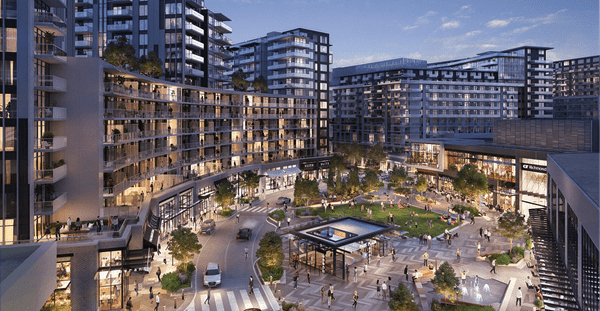Draughty town halls and community centres, inconvenient consultation times and old-fashioned presentation materials; it’s no wonder people often don’t engage with plans and proposals for their local community. But when it comes to planning for the future, who knows an area and its needs better than the people who live there?
Even before COVID-19 hit, maximizing the engagement of local people in planning decisions could be challenging and resource intensive, and the entire process was ripe for overhaul. How do we make the engagement process as easy as possible for people living busy lives? How do we ensure they are able to see the value of their contributions? And how can we ensure that the process itself can add value enough that community members want to engage?
Like so many other sectors, we knew digitisation could be an important part of the solution, but what we didn’t know was how to leverage technology to get to the heart of the problem and bring urban planning to life for local communities.
Making community consultation accessible for all
When it comes to shaping a community, everyone deserves to have their voice heard. The problem is, we all have busy lives and finding the time to comment on ideas, plans and proposals often falls a long way down the list of daily priorities. Younger age groups are typically under-represented in community consultation. And if we factor in the relatively new phenomenon of social distancing and a potential reluctance to be around too many people – particularly amongst older age groups - we’re missing out on sharing information and receiving important feedback from whole swathes of society.
Now imagine if these people could have the option to find information, review plans, comment and share feedback, whenever and wherever they wanted. They could be scrolling on their phone on the bus, or they could be sitting in the comfort of their own armchair at home. For those without smart phones, there could be the option to provide input simply and easily on tablets in cafes or libraries.
Community engagement needs to be accessible, inclusive, and easy – and this is exactly what we found when we started working with Irys.
Digital engagement tools
Founded in 2017, the team at Irys were well ahead of the curve in developing cutting edge, human-centric engagement tools. For us, this had the potential to be game-changing when it came to increasing community involvement and improving collaboration and decision making across our own projects.
Whether we’re managing the development of new transport infrastructure, building a new residential community, regenerating our high streets or protecting an area from flooding, the most important thing is making sure that we understand and fully integrate the perspectives of people who could be impacted by, or could impact, the project development process or its outcomes. Bringing in the voice of local people and local stakeholders is essential when it comes to understanding the challenges and making sure that our solutions are the right ones for that community, in that situation.
To help us do this, Irys has pioneered the use of modular-based System as a Service (SaaS) digital platforms and engagement tools. SaaS essentially means that data can be accessed from any device with an internet connection and web browser, which in turn means the platforms can seamlessly collect, manage, and share or report back information. This helps to ensure the voices of citizens and communities are heard throughout a project lifecycle, and in turn provides transparency by helping people understand how their input is being integrated, all the way from design and planning to completion.
Sharing information
Of course, community engagement is a two-way process. We want to listen to local people, but we also want to make sure we’re giving them regular updates as plans are progressing, so they understand the changes taking place in their community, and can provide feedback in real time.
Working with Irys has made this possible. We can send people surveys via the app, asking them what they love or want to change about their neighbourhood. Do they want more cycle lanes? Does the streetlighting on a particular road or junction need to be improved? All of this data can be visualised on a dashboard and map, with feedback in real time. With actionable information, it means that we can adapt and tailor projects, or fix problems as soon as they arise.
This depth of local information is a huge bonus. But it also brings some real long-term benefits when it comes to building a sense of stewardship amongst the community. Unlike other social media platforms, such as facebook, this is a closed, safe space where people can see the direct and positive results of speaking up. This provides an important outlet, empowering people to be engaged in decisions affecting their community.
Obviously, an app can’t replace everything we do physically. Digital exclusion is still a big societal issue, so we need to make sure we still use traditional face-to-face consultation processes as well. But with Irys, we have access to another new and important channel. As the platform grows, we can organically adapt and evolve our approach, shaping the tool and how we use it in tandem with the changing needs of our clients and communities.
From the US to the UK
We’ve already seen the value of using the app in the US. For example, it’s something we’ve begun using to help develop action plans to address flooding.
With valuable input from the public and other stakeholders, use of the app in the US has helped us to understand the specific impact that flooding can have both on people’s lives and an area’s economy. By working with local people to understand what they want their region to look like, and what they want their relationship with water to be over the next 50 years, we can develop a roadmap for the future. We have been able to identify flood risk reduction strategies to help realise the vision and decrease vulnerability to future flood risk.
The main focus for our Irys US projects at the moment is understanding and responding proactively to community members’ visions for the future as well as possible infrastructure damage and societal impacts from natural disasters and climate change. This goes hand-in-hand with the rapidly increasing importance of sustainability and need to meet adaptation goals.
But the real beauty of the Irys app is the diversity of application. Every single development, from flood resilience strategies to community master-planning, can be layered on a visualisation map to give everyone a single view of what is happening locally.
The result is a much wider understanding of the built environment. We want people to be more engaged with local projects and use the app as a tool to explore – and influence – what’s happening in their neighbourhood or community. It’s this level of local input, knowledge and understanding that is invaluable for shaping future plans. And if we’re going to succeed in creating an urban environment that meets the needs of an entire community, then we need to make sure that the entire community is empowered to share their views.
A pivot from traditional engagement tools
The vision for the Irys app is that it will one-day provide a one-stop shop for community members to see and engage with all the decisions that are underway that could affect their community – from new developments to policy changes, to master and resilience plans and new capital improvements. To that end, Irys is beginning pilot programs in 15 cities across the US to data mine and source information about decisions affecting those communities and making them available in one place for community members. Watch out for the outcomes of these pilots over the next year. It is our ambition that, one day, civic engagement becomes as seamless and integral to daily life as food shopping.
Contact Alison Powell at alison.powell@arcadis.com
Contact Carly Foster at carly.foster@arcadis.com






